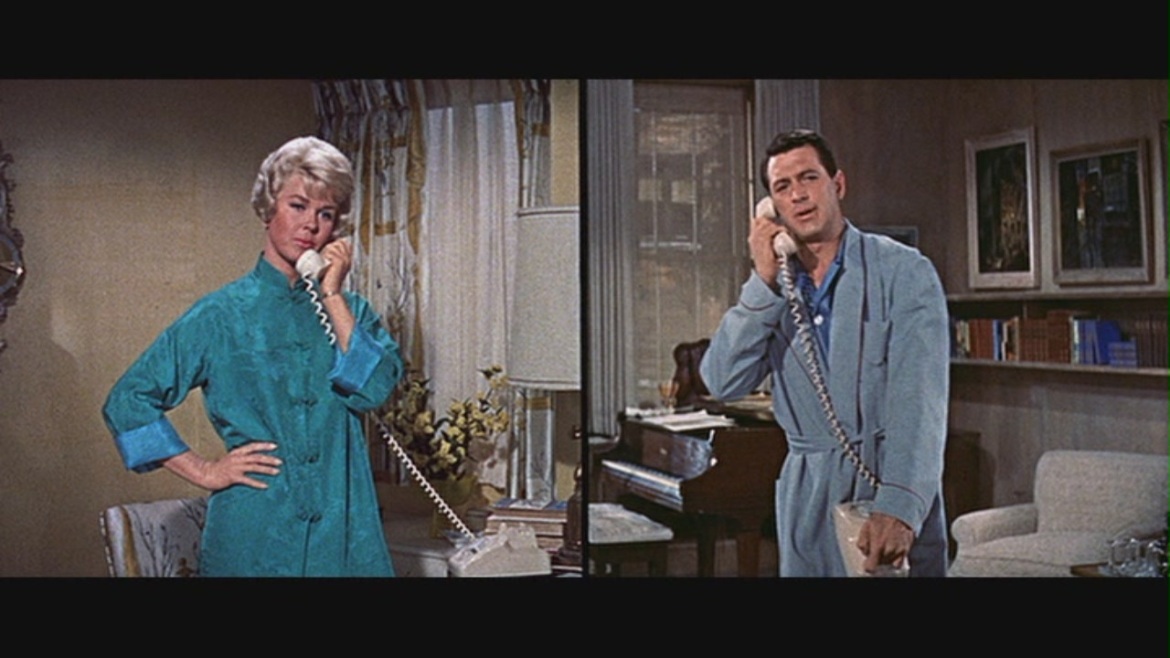The on-screen partnership of Doris Day and Rock Hudson is a fondly remembered one in Hollywood history. The actors made three features together: Pillow Talk, Lover Come Back, and Send Me No Flowers. Of these movies, Pillow Talk has been the most successful, finding an easy staying power in the collective memory of popular culture. However, when examining Pillow Talk (as well as Day’s star persona), they are not only complicated, but are even potentially problematic when viewed through a contemporary lens.
Pillow Talk follows interior designer Jan Morrow (Day). Unable to get her own phone line in her apartment, Jan must share a “party line” with lothario songwriter Brad Allen (Hudson). It only takes a few conversations for these two polar opposites to learn they can’t stand each other. However, when Brad finally meets Jan, he finds himself falling hard for her. However, there’s one problem. Would Jan even give Brad Allen the time of day? To combat this, he adopts a new personality. The saavy New York songwriter becomes Rex Stetson, an innocent and naive cowboy visiting from Texas. Jan is immediately smitten with Rex. However, will she be able to see beyond her tense relationship with Brad when she learns of Rex’s true identity? The film is directed by Michael Gordon from a script by Stanley Shapiro and Maurice Richlin.

Doris Day was one of the biggest female box office attractions during the post-World War II period. In the following decades, a chaste and virginal archetype permanently attached itself to her career. Is this truly deserved? This characterization is clearly visible in her early musicals like the sickeningly innocent (but adorable) By The Light of the Silvery Moon and On Moonlight Bay. However, when looking at her later roles (especially Jan Morrow in Pillow Talk) the image doesn’t seem to fit quite as easily.
Jan Morrow is a successful and independent career woman. In his book, Considering Doris Day, Tom Santopietro writes about Jan. “She didn’t depend on any man for her happiness. She was working because she loved it and was good at her job, not because she wanted to snare a man…”. In the film, Jan lives a glamorous New York lifestyle. She has an amazing apartment, and owns a fancy wardrobe. In fact, in his coverage of Day’s career, Santopietro finds a realism in her work. “Doris Day and her style were…more approachable and imitable than those of other 1960s fashion icons (like) Jackie Kennedy and Elizabeth Taylor”. Reading further into this point, Jan’s development grows in importance. She is unapologetic about her life. She doesn’t mind being single, which is often a fate worse than death in this era.

Rather, Jan Morrow’s depiction in popular culture seems imprinted on her by the narrative. When her relationship with Brad is at its’ most tense, it is he who depicts her as a sex obsessed spinster. Brad tells her, “Look, I don’t know what’s bothering you, but don’t take your bedroom problems out on me”. Her response is quick, “I have no bedroom problems. There’s nothing in my bedroom that bothers me.”. However, his final retort controls the conversation. The comment is simple, but powerful. “Ohhh. That’s too bad”. In another scene, Jan interrupts Brad when he’s on the line with one of his many conquests. Brad tells the other woman that Jan listens on his calls to liven up her boring sex life.
Brad’s comments throughout the story cement Jan’s status as a frustrated spinster more than anything present in Day’s performance. It leads to the question, have the views of others, namely the male characters appearing opposite her, come to define Jan Morrow? Throughout 75 percent of the film, Brad Allen holds tremendous power over the narrative. Everything and everyone in the story is Brad’s plaything. This includes the women he dates. While he’s pretending to be Rex, he’s constantly manipulating Jan into developing feelings for him. Does this power extend to the popular perception of the film?
Much of Pillow Talk’s reputation is clouded with popular culture’s ideas about Doris Day’s star persona. However, there is little evidence in the movie to back up the claims that Jan is a frustrated spinster. Throughout the film, Jan Morrow is developed as an intelligent and independent career woman. While her character is incredibly progressive in 1950s cinema; unfortunately, the collective societal memory has defined not only Jan Morrow, but Doris Day as well, in this chaste and simple way. There are more films in Day’s lengthy career to study. However, there seems to be more to Doris Day than the perennial virgin label which has been stuck to her career since the 1950s.

Episode 44: Dame – Impossible – Citizen Dame
[…] Pillow Talk […]